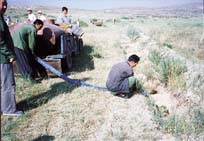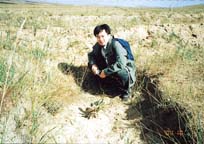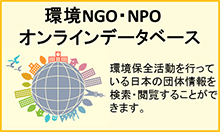

Forest Farm Planting in the Gobi Desert
Examples of Granted Projects
Forest Farm Planting in the Gobi Desert -China-
Desert Planting Volunteer Association President, Yutaka Kikuchi
Our organization is involved with a forestation program in Desheng Village, located in China's Inner Mongolia, 300 kilometers to the northwest of Beijing City and 1,300 meters above sea level. An arid plateau with 300 mm of annual rainfall, this area was grassland home to nomads a century ago. However, the later settlement of an agricultural people (the Han Chinese) introduced extensive farming and year-round overgrazing, which gradually turned the area into wasteland, and eventually, the Gobi Desert (covered with gravel, the surface soil having been blown away by strong winds). Thus, the area is now a poverty-stricken farming village (growing mainly potatoes) with an annual disposable income of 1,000 Yuan (15,000 Japanese Yen) per capita.
What is a Forest Farm?

The tree planting cooperation team and local residents jointly bed out nursery trees.
Windbreak forests are planted to prevent soil erosion afflicted by winds, thus stimulating the revival of the natural flora. The land is then divided up for use as forest, in-forest grassland and in-forest farmland, according to the nature of the soil. A forest farm comprises a mixture of different tree types capable of withstanding aridity, strong winds and frigid climate - namely, timber, feed (leaves), fertilizing, flowering and fruit trees - and is capable of symbiosis with a stable ecosystem (where phanerophyte and soil biota have soil stabilizing and recharging functions).
Achievements and Challenges

Root Study: The green trees had firmly taken root.
Despite our experiences in desert (a general term for barren land covered with rocks, gravel, dirt, sand and salt) forestation, compared with those in the Horqin Desert, where twelve years of field work have given us accumulated know-how and where local residents have been encouraged to voluntarily plant trees (amounting to 24ha in 2002) using the appropriate (simple, low-cost and stable) technology, our short history in Gobi (gravel-covered desert) of merely two years holds yet many challenges.
- (1) Experimental Planting of Suitable Trees
We have planted native species, including spruces, oaks, white birches, elms and pines, limiting poplars, promoted by the local government, to the plains. We have been experimenting their initial growth on additional soil, but the complexity of soil type presents many difficulties for standardization. - (2) The Natural Flora of Forests
The utilization of chain-link barriers to restrict grazing has resulted in more plant growth than expected. However, the smell of grass has attracted livestock grazing in surrounding pastures into the area, only to cause damage, and thus the recovered flora can be observed in patches. - (3) Local Awareness and Voluntary Tree Planting
Article 18 of the Chinese Forest Law guarantees those who reforest land land use rights for a period of fifty years. However, local residents still seem skeptical of the system and many continue to engage in exploitative farming for its immediate profit, and hence the limitedness of voluntary tree planting activities.
Contact
Desert Planting Volunteer Association
51 Osaka, Ikawamura, Isawagun, Iwate Prefecture 029-4406
TEL: +81-43-255-8648
FAX: +81-43-255-8648
URL: http://homepage2.nifty.com/sashoku/

Download Adobe Reader
Adobe Reader is required to view Portable Document Format PDF files.
 adobe readerダウンロード
adobe readerダウンロードPDF形式のファイルはadobe readerが必要です。
















